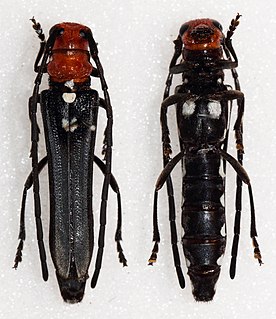Related Research Articles

Eulophia, commonly known as corduroy orchids, is a genus of about two hundred species of flowering plants in the orchid family, Orchidaceae. Most Eulophia orchids are terrestrial but some are deciduous while others are evergreen. They either have an underground rhizome or pseudobulbs on the surface and those species with leaves have them on the end of a fleshy stem. The flowers are arranged on a thin flowering spike, the flowers having sepals which are larger than the petals. The genus is widely distributed but most species are found in Africa and Asia, usually growing in shady places with grass or shrubs in forests.

Elaeis is a genus of palms containing two species, called oil palms. They are used in commercial agriculture in the production of palm oil. The African oil palm Elaeis guineensis is the principal source of palm oil. It is native to west and southwest Africa, occurring between Angola and Gambia. The American oil palm Elaeis oleifera is native to tropical Central and South America, and is used locally for oil production.

The tiny serotine is a species of vesper bat.

The Guinean horseshoe bat is a species of bat in the family Rhinolophidae. It is found in Ivory Coast, Guinea, Liberia, Senegal, and Sierra Leone. Its natural habitats are subtropical or tropical dry forest, subtropical or tropical moist lowland forest, subtropical or tropical moist montane forest, moist savanna, caves, and subterranean habitats. It is threatened by habitat loss.
Arctides guineensis is a species of slipper lobster which lives in the Bermuda Triangle. It is known in Bermuda as the small Spanish lobster, a name which is also favoured by the FAO.

Leuconitocris is a genus of longhorn beetles of the subfamily Lamiinae, containing the following species:
Leuconitocris obereoides is a species of beetle in the family Cerambycidae. It was described by Stephan von Breuning in 1956.
Leuconitocris pseudolucasi is a species of beetle in the family Cerambycidae. It was described by Stephan von Breuning in 1956.
Leuconitocris microphthalma is a species of beetle in the family Cerambycidae. It was described by Stephan von Breuning in 1950, originally under the genus Nitocris. It is known from Sierra Leone and the Democratic Republic of the Congo.
Leuconitocris argyrostigma is a species of beetle in the family Cerambycidae. It was described by Per Olof Christopher Aurivillius in 1914.
Leuconitocris argenteovittata is a species of beetle in the family Cerambycidae. It was described by Per Olof Christopher Aurivillius in 1914.
Leuconitocris aurigutticollis is a species of beetle in the family Cerambycidae. It was described by Pierre Téocchi in 1998.

Leuconitocris leucostigma is a species of beetle in the family Cerambycidae. It was described by Harold in 1878. It has a wide distribution in Africa.
Leuconitocris buettneri is a species of beetle in the family Cerambycidae. It was described by Hermann Julius Kolbe in 1893.
Leuconitocris gigantea is a species of beetle in the family Cerambycidae. It was described by Nonfried in 1892.
Leuconitocris nigricornis is a species of beetle in the family Cerambycidae. It was described by Olivier in 1795, originally under the genus Necydalis. It is known from Tanzania, South Africa, the Central African Republic, Mozambique, Uganda, Malawi, and Zambia.
Leuconitocris pascoei is a species of beetle in the family Cerambycidae. It was described by James Thomson in 1858. It is known from Gabon.
Leuconitocris schultzei is a species of beetle in the family Cerambycidae. It was described by Hintz in 1919.
Leuconitocris tibialis is a species of beetle in the family Cerambycidae. It was described by Kolbe in 1893, originally under the genus Nitocris. It contains the varietas Leuconitocris tibialis var. holoflava.
References
- ↑ BioLib.cz - Leuconitocris guineensis. Retrieved on 8 September 2014.